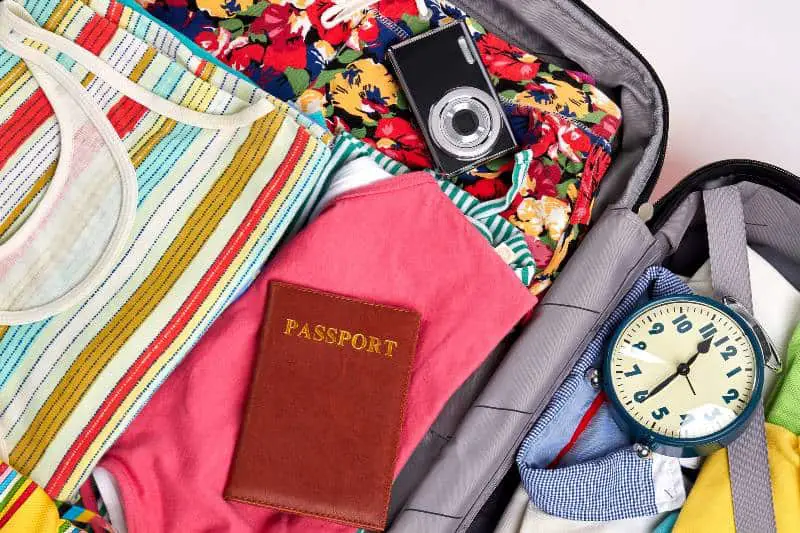Getting Ready for Thailand: Your Ultimate Packing Guide
Moving to a new country can be both an exciting and daunting experience. When you’re moving somewhere exotic like Thailand, it adds another layer of complexity – what do you need to take with you? From clothes, electronics, and toiletries, to personal items that will help make your transition smoother – there is a long checklist of things required for the big move. Fortunately, this blog post has all the suggestions and advice you’ll need when deciding what to pack, we call this the ‘ultimate Thailand packing list!’ when making the journey from your home country to Thailand!
When moving to Thailand, it’s important to pack appropriately. Include lightweight clothing for the tropical climate, important documents, necessary medications, key tech gadgets, toiletries, and items to respect local customs. Remember, pack smart, not heavy, as many things are readily available locally.
Key Takeaways
- If you plan to visit temples or religious sites in Thailand, make sure to dress appropriately by covering your shoulders and knees.
- Despite the hot and humid climate of the country, it’s still necessary to wear lightweight and breathable clothing. If you’re visiting during the rainy season, be sure to bring rain protection as well.
- Make sure to bring important health and hygiene items such as prescription medication, over-the-counter remedies for minor illnesses, sunscreen, and insect repellent.

Why choose Thailand as a new home
Thailand experiences three distinct seasons with varying temperatures throughout the year. From February to May, it is hot and dry. From June to October, it is the monsoon season. Lastly, from November to January, it is a cooler and dry season. The average temperatures range from 23.0 °C to 32.2 °C.
Thailand is a Southeast Asian country located between Cambodia, Myanmar, and Laos. Its southern coast is bordered by the Gulf of Thailand. The melting pot of Thai culture is a colorful blend of Indian, Chinese, and unique Thai customs.
Thailand’s long and complex history has played an influential role in shaping its culture. The country was once known as Siam until 1939. Over time, numerous invasions, including those from the Burmese and Khmer empires, have disrupted the country’s peace. However, those encounters are what contributed to the diverse blend of traditions you see today.
In addition to its cultural traditions, Thailand is known for its beautiful beaches and tropical climate, making it a popular destination for tourists around the world.
The “Land of a Thousand Smiles” is a must-see destination in Southeast Asia due to its varied geography, hospitable locals, and breathtaking landscapes.
While Thailand hasn’t had an absolute monarchy in over a century, there is still a social rank in place. Thai citizens show greater respect towards specific groups, including the royal family and monks.
Thai culture includes strong values emphasizing respect toward elders and benefactors, such as parents and teachers. Hence, one may observe a high level of respect in Thai interactions with such individuals.
Thailand is referred to as “the land of smiles” due to the prevalence of smiles on the faces of Thai people. Although Thai people are amicable, visitors may be amazed to learn that a smile does not necessarily indicate happiness.
In Thai culture, different types of smiles can convey a variety of emotions, including pleasure and anger. However, it is often difficult to discern any negative emotions because saving face and avoiding conflict are highly valued in Thai society.
Thailand is renowned for its Buddhist statues which are prevalent throughout the country, in addition to its friendly locals. Buddhism is the country’s official religion, and more than 90% of Thais follow it. It’s typical to encounter Buddhist monks wearing traditional robes as you wander around.
Learning the basics of Buddhism can be helpful if you want to learn Thai. You don’t need to become a Buddhist to learn the language, but understanding the religion can help you understand the country better. Most Thai philosophies are influenced by Buddhism, but modern Thai culture is diverse and open-minded. Due to this, Thai people are also influenced by other religions and beliefs to some extent.
Essential Clothing to Pack
What types of clothing to bring
Known for its tropical climate and cultural richness, requires thoughtful Thailand packing list items to ensure comfort and respect for local customs. Men and women should pack lightweight, breathable clothing to cope with the typically hot and humid conditions. These could include loose-fitting pants, shorts, dresses, and t-shirts, preferably made of cotton or linen.
In Thailand, it’s advisable to dress modestly, particularly when visiting temples or other religious sites. Women should bring scarves or shawls to cover their shoulders, and both men and women should have clothes that cover their knees. It’s always a good idea to carry a light sweater or jacket, as air conditioning can be quite strong in hotels, restaurants, and transportation hubs.
If visiting during the rainy, quite cool season (typically July to October), a lightweight, waterproof jacket or poncho, plastic bags, and possibly a compact travel umbrella, are good additions to your suitcase. Despite the occasional downpours, the temperature remains high, so heavy-duty rain gear isn’t necessary.
Also, flip-flops, packing cubes, hiking boots, and travel insurance are very essential when you pack for Thailand!
Importance of respectful attire
Respectful attire is important for various reasons, especially when traveling or interacting in different cultures.
First, wearing respectful attire demonstrates understanding and acceptance of the local culture and norms. Different countries and cultures have different standards for what is considered appropriate. In some places, exposing too much skin or wearing certain types of clothing can be seen as disrespectful.
Second, it can show respect for specific social situations. For example, formal events often require different types of clothing than casual ones. Wearing the appropriate attire to such events shows respect for the host and the event itself. In professional settings, dressing appropriately can signify respect for the job, the employer, and oneself.
Third, in many religious contexts, respectful attire is particularly important. Many religions have specific guidelines for what is considered appropriate to wear, especially in sacred places. This could range from covering one’s head in certain Christian churches and Sikh temples to covering arms and legs in Buddhist temples and Muslim mosques.
Necessary Documents for Thailand
To travel to Thailand, you will generally need the following documents:
- Passport: Your passport should be valid for at least six months beyond the date of your entry into Thailand.
- Visa: Depending on your country of origin and the length and purpose of your stay, you may need a visa to enter Thailand.
- Tourist Visa: This is required for certain nationalities, and it typically allows a stay of up to 60 days.
- Visa Exemption: Passport holders from certain countries, including the United States, Canada, Australia, and most European countries, do not need a visa for stays of up to 30 days if entering by air, or 15 days if entering overland.
- Visa on Arrival: Passport holders from certain countries can apply for a visa on arrival for stays of up to 15 days.
Please note that these policies may have changed after my last training data in September 2021, and the exact requirements can vary based on your country of residence. Also, Thailand’s visa policies can change in response to various factors including the COVID-19 pandemic.
For the most accurate and current information, you should always check with the nearest Thai embassy or consulate, or their official immigration website, before your departure. They will be able to provide the most up-to-date information on visa requirements and any other necessary documents you may need to provide upon arrival.
Health and Hygiene Products
What to bring and what you can find locally
When traveling to Thailand, it’s a good idea to pack travel essentials like health and hygiene products, while keeping in mind that many items can be purchased locally in case you forget something or run out.
Items to consider packing include:
Prescription Medication: If you have any prescription medication, make sure to bring enough for the duration of your trip, along with a copy of your prescription. It’s also recommended to keep these in their original packaging to avoid any potential issues with customs.
Over-the-counter Medication: It’s a good idea to bring a small first aid kit, including items like pain relievers, antacids, and band-aids. If you have preferred brands, you might want to bring those from home.
Sunscreen: Thailand’s sun can be intense, so high-factor sunscreen is a must. While sunscreen is available in Thailand, it might be more expensive or not of the same quality as you are used to.
Insect Repellent: This is especially important if you’re going to be spending time in rural areas or near bodies of water. Many places in Thailand have mosquitoes and there is a risk of dengue fever and malaria.
Travel-sized Toiletries: While these can be found in Thailand, if you have specific brands you prefer, it’s better to bring them from home. These include items like toothpaste, shampoo, conditioner, and soap.
Hygiene Products: Women should note that while tampons and sanitary pads are available in most places, the brands and types may be limited. If you have a preferred brand, you might want to bring it from home.
Hey, good news if you’re heading to Thailand! You’ll find a variety of convenience stores and pharmacies stocked with health and hygiene products. In bigger cities and tourist spots, you’ll come across 7-Eleven, FamilyMart, and other chains. Local pharmacies carry a range of local and international brands. Forgot or ran out of something? Chances are, you’ll find it there! But if you need something specific or prescribed, bring enough from home to last your whole trip.
Electronics and Adapters
What type of electronics to bring
The electronics you should bring with you to Thailand will depend on your individual requirements and the type of trip you are taking.
Common electronics that travelers bring include:
- Smartphone: Useful for communication, maps, translation apps, and more.
- Camera: If you’re an avid photographer or just want to capture your memories, bring a camera. However, if you’re not picky about image quality, your smartphone might be sufficient.
- Tablet or e-reader: If you plan on doing a lot of reading, an e-reader can be a lightweight alternative to physical books.
- Laptop: If you’re a digital nomad, business traveler, or need to work during your trip, a laptop is essential.
- Power bank: Given the heavy use of electronics while traveling, having a power bank to charge your devices on the go can be incredibly useful.
Travel adapter and voltage converter: Thailand uses Types A (two flat parallel pins), B (two flat parallel pins and a grounding pin), and C (two round pins) outlets. The standard voltage is 220V, and the frequency is 50Hz. Check the voltage range on your devices to ensure they can handle the 220V standard. Most modern chargers for phones, laptops, tablets, and cameras are designed to handle a range of voltages, but it’s always better to be safe and check the label on your charger.
If your devices don’t support 220V and/or use different plug types, you will need to bring a voltage converter and/or plug adapter. A universal travel adapter can cover you in multiple countries and is a handy tool for any international traveler.
It’s also important to remember that you can buy most electronics in Thailand if you need to. However, be aware that they can sometimes be more expensive due to import taxes, and you’ll need to consider warranties and the compatibility of these devices with your networks or systems back home.
As always, when traveling with electronics, ensure they are securely packed and properly protected, and remember to back up your data regularly.
Miscellaneous Items
When it comes to personal items and hobby-related materials, the key is to consider the practicality and necessity of bringing them from home versus acquiring them in Thailand.
Books: If you’re an avid reader, you may want to bring a few books. However, keep in mind that books can be heavy and take up too much space. E-readers are a lightweight alternative.
Hobbies: For those who have hobbies like painting, knitting, or writing, consider how much of your time in Thailand will be dedicated to these activities. Pack what you’ll reasonably use, but remember that art supplies, yarn, stationery, and other similar items can be bought locally.
Sports and Outdoor Equipment: If you plan on partaking in activities such as yoga, surfing, or rock climbing, you’ll have to decide whether to bring your gear or rent/buy it there. For bulky items, it’s often easier to rent them locally unless you have specific preferences or needs.
Snacks: If you have specific dietary needs or crave comfort foods from home, pack some of your favorite non-perishable snacks. Just ensure they’re sealed and comply with customs regulations.
Gifts: If you plan on meeting locals or friends and want to bring gifts, small items representative of your home country can be a great idea.
As for items that are cheaper to buy in Thailand:
Clothing: Thailand, particularly Bangkok, is well-known for its shopping. Clothes, especially local brands or items like Thai silk or cotton, can be much cheaper than in Western countries. Markets like the Chatuchak Weekend Market in Bangkok offer a wide range of inexpensive clothing options.
Handicrafts: Locally made crafts, artwork, and jewelry can be quite affordable. These can make great souvenirs or gifts.
Street Food: While not an item you take home, it’s worth mentioning that Thailand is famous for eating street food, which is incredibly delicious and very cheap compared to restaurant prices in many Western countries.
Local Produce: Exotic fruits, vegetables, and local snacks are generally much cheaper in Thailand than they would be in Western supermarkets.
Lastly, remember that negotiating prices in markets is a common practice in Thailand. Don’t be afraid to haggle politely – it’s part of the shopping experience. However, always maintain respect and remember that the small amount of money you’re haggling over likely means a lot more to the vendor than to you.

What To Pack When Moving To Thailand FAQs
Which personal items should I consider bringing to Thailand?
It may be beneficial to pack items that are either hard to find or more expensive in Thailand, such as books, materials for hobbies, non-perishable snacks, and items that bring you comfort. However, clothing is usually cheaper to purchase in Thailand, and outdoor and sports equipment can be rented or bought locally.
Are there items that are cheaper to buy in Thailand rather than bringing from home?
In Thailand, clothing, handicrafts, artwork, jewelry, street food, and local produce are generally less expensive. It’s common to negotiate prices in markets, so feel free to engage in polite haggling.
How does the climate in Thailand affect what I should pack?
To prepare for the hot and humid climate in Thailand, bring lightweight and breathable clothes. It’s also wise to pack hats, sunscreen, sunglasses, and bug spray or repellent to guard against the sun and mosquitoes. Ensure your electronics are suitable for the tropical climate as well.
Is it necessary to bring specific medications to Thailand?
It’s recommended to bring your regular medications with you in case they are not available or expensive in Thailand. But before traveling, it’s important to consult with a doctor and check the local laws regarding medications. And don’t forget to bring prescriptions for all your medicines.
What’s the importance of respectful attire in Thai culture?
When packing for Thailand, it’s important to consider the local culture and customs. Women should pack modest clothing that covers their shoulders and thighs. Men should avoid tank tops or shorts above the knee. It’s also helpful to be aware of what items are frowned upon in Buddhist temples, such as shoes with heels or revealing clothing. Remember to dress respectfully
Conclusion
If you’re planning to travel to Thailand, whether it’s for a spiritual pilgrimage or a relaxing holiday, make sure to dress modestly out of respect for the cultural norms. Bring appropriate clothing for each season and climate, as well as important health and hygiene items like sunscreen and insect repellent. Plan ahead so that you can enjoy your Thailand trip to its fullest.
Remember that it’s not just about exploring the temples but also keeping in mind cultural standards while having fun! If you have any questions about making the most of your stay in Thailand, feel free to reach out. We will be more than happy to help answer your questions and provide advice about ideas for places to explore. Subscribe to our newsletter if you want more insights on living in Thailand. So make sure to keep these tips in mind when traveling through sacred sites and cities of Thailand.






